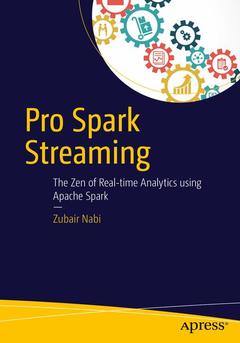Pro Spark Streaming, 1st ed. The Zen of Real-Time Analytics Using Apache Spark
Auteur : Nabi Zubair

Learn the right cutting-edge skills and knowledge to leverage Spark Streaming to implement a wide array of real-time, streaming applications. This book walks you through end-to-end real-time application development using real-world applications, data, and code. Taking an application-first approach, each chapter introduces use cases from a specific industry and uses publicly available datasets from that domain to unravel the intricacies of production-grade design and implementation. The domains covered in Pro Spark Streaming include social media, the sharing economy, finance, online advertising, telecommunication, and IoT.
In the last few years, Spark has become synonymous with big data processing. DStreams enhance the underlying Spark processing engine to support streaming analysis with a novel micro-batch processing model. Pro Spark Streaming by Zubair Nabi will enable you to become a specialist of latency sensitive applications by leveraging the key features of DStreams, micro-batch processing, and functional programming. To this end, the book includes ready-to-deploy examples and actual code. Pro Spark Streaming will act as the bible of Spark Streaming.What You'll Learn
- Discover Spark Streaming application development and best practices
- Work with the low-level details of discretized streams
- Optimize production-grade deployments of Spark Streaming via configuration recipes and instrumentation using Graphite, collectd, and Nagios
- Ingest data from disparate sources including MQTT, Flume, Kafka, Twitter, and a custom HTTP receiver
- Integrate and couple with HBase, Cassandra, and Redis
- Take advantage of design patterns for side-effects and maintaining state across the Spark Streaming micro-batch model
- Implement real-time and scalable ETL using data frames, SparkSQL, Hive, and SparkR
- Use streaming machine learning, predictive analytics, and recommendations
- Mesh batch processing with stream processing via the Lambda architecture
Data scientists, big data experts, BI analysts, and data architects.
Chapter Goal: Introduce the reader to Spark in general. This book does not assume that the reader is already familiar with Spark.
Sub -Topics
- Introduction to Spark and its key selling points
- The programming model
- Architecture
- Introduction to other systems within the ecosystem, such as MLlib, GraphX, SparkSQL, and SparkR
Chapter Goal: Introduces Spark Streaming and the concept of micro batch processing (DStreams)
Sub - Topics
- Introduction to Spark Streaming/DStreams
- Comparison with traditional stream processing
- How Spark Streaming works under the hood
- Programming API and how it relates to the general Spark API
- First sample application using FileInputDStream
Chapter Goal: To transfer best practices in terms of application development
Sub - Topics:
- Maintaining state in an application
- Data caching to reduce redundant work
- Offloading RDD maintenance to Tachyon
- Fault-tolerance and check-pointing
Chapter Goal: To enable the reader to understand the various data ingestion options, their pros and cons, and their integration with Spark Streaming
Sub - Topics:
1. Introduction to Receivers
2. Kafka
3. Twitter
4. Flume
5. Other sources
6. Writing your own connector. Example Apache Qpid
Chapter 5: Optimizing and maintaining a Spark Streaming application/deploymentChapter Goal: To help the user in optimizing an application and how it can be maintained in production
Sub - Topics
- Different configuration parameters and how they affect the application
- Parallelism
- Serialization, memory, etc. enhancements
- Various monitoring and instrumentation options
Chapter Goal: To illustrate how a SQL/Dataframe interface can simplify common transforms
- Introduction to SparkSQL and SQLContext
- Various SQL constructs
- Integration with R
- Design of a few real-world applications
Chapter Goal: Employ MLlib to implement streaming machine learning applications
- Introduction to streaming algorithms in MLlib
- Real-world applications using streaming MLlib
Chapter Goal: Blending data at rest with data in motion
- Introduction to the Lambda Architecture
- Design of Lambda Architecture using Spark
Chapter Goal: Introduction to Spark Streaming in Java and Python
- Java API
- Python API
Chapter Goal: Overview of some of the future plans for Spark Streaming from the ope
n source community- Project Tungsten and how its CPU and memory improvements can benefit streaming applications
- Links to useful resources
Highlights the differences between traditional stream processing and the Spark Streaming micro-batch model
Targets real-world applications from multiple industry verticals
Provides an introduction to other popular Big Data solutions, such as Apache Kafka
Date de parution : 06-2016
Ouvrage de 230 p.
17.8x25.4 cm
Disponible chez l'éditeur (délai d'approvisionnement : 15 jours).
Prix indicatif 36,91 €
Ajouter au panier


